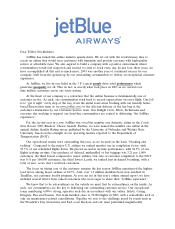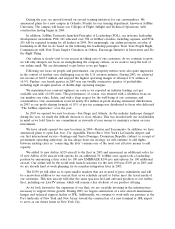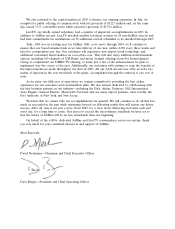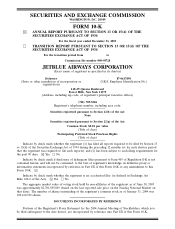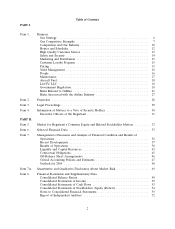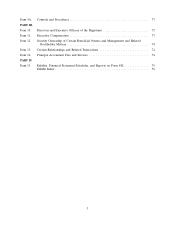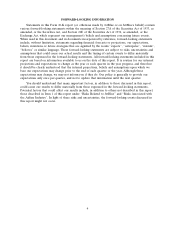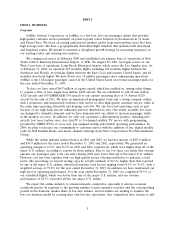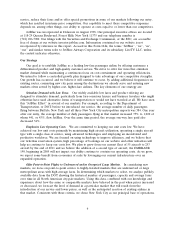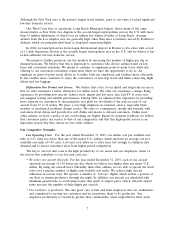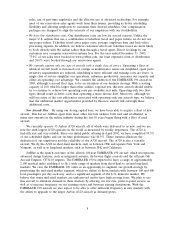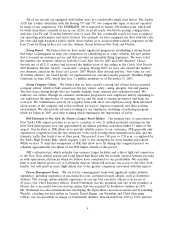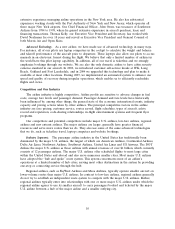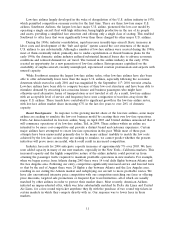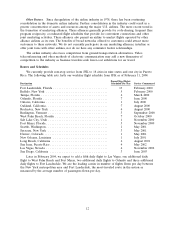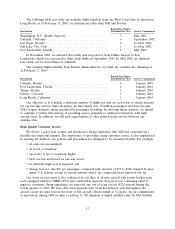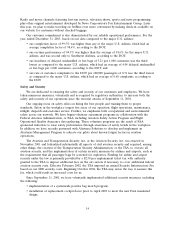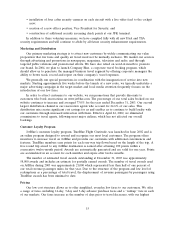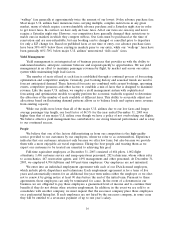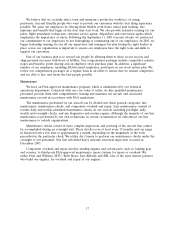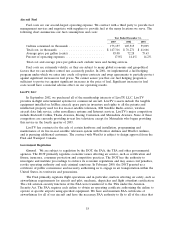JetBlue Airlines 2003 Annual Report Download - page 11
Download and view the complete annual report
Please find page 11 of the 2003 JetBlue Airlines annual report below. You can navigate through the pages in the report by either clicking on the pages listed below, or by using the keyword search tool below to find specific information within the annual report.rules, use of part-time employees and the effective use of advanced technology. For example,
most of our reservation sales agents work from their homes, providing us better scheduling
flexibility and allowing employees to customize their desired schedules. Our compensation
packages are designed to align the interests of our employees with our stockholders.
•We have low distribution costs. Our distribution costs are low for several reasons. Unlike the
major U.S. airlines that use a combination of ticketless travel and paper tickets, we do not use
any paper tickets. Ticketless travel saves paper costs, postage, employee time and back-office
processing expense. In addition, we believe customers who book ticketless travel are more likely
to book directly with the airline rather than through a travel agent. Direct bookings by our
customers save computer reservation systems fees. For the year ended December 31, 2003,
73.0% of our sales were booked on www.jetblue.com, our least expensive form of distribution,
and 24.6% were booked through our reservation agents.
•We currently operate only one type of aircraft, with a single class of service. Operating a fleet of
identical aircraft leads to increased cost savings as maintenance issues are simplified, spare parts
inventory requirements are reduced, scheduling is more efficient and training costs are lower. A
single class of service simplifies our operations, enhances productivity, increases our capacity and
offers an operating cost advantage. We consider the addition of the EMBRAER 190 aircraft in
2005, although a second fleet type, to be an extension of our business strategy. With a seating
capacity of 100, which is larger than other airlines’ regional jets, this new aircraft should enable
us to continue to achieve low operating costs per available seat mile. Operating only two fleet
types should result in lower costs than operating a more diverse fleet. Moreover, although we
will lose some of the cost efficiencies associated with operating only one aircraft type, we believe
that the additional market opportunities provided by this new aircraft will outweigh these
additional costs.
New Aircraft Fleet. By using our strong capital base, we have been able to acquire a fleet of new
aircraft. This has set JetBlue apart from most other low-fare airlines, both new and established, as
many new entrants in the airline industry during the last 10 years began flying with a fleet of used
aircraft.
We currently operate 55 Airbus A320 aircraft, all of which were delivered to us new, and we are
now the sixth largest A320 operator in the world as measured by weekly departures. The A320 is
fuel-efficient and very reliable. Since our initial public offering in April 2002, we have completed 99.5%
of our scheduled flights and our on-time performance was 84.5%. These statistics illustrate the
dedication of our employees and the reliability of the A320 aircraft. The A320 is also a versatile
aircraft. We fly the A320 in short-haul markets, such as between JFK and upstate New York and
Vermont, as well as in long-haul markets, such as between JFK and California.
JetBlue is the launch customer of the all-new 100-seat EMBRAER 190 aircraft, which incorporates
advanced design features, such as integrated avionics, fly-by-wire flight controls and the efficient GE
Aircraft Engines’ CF34-10 engines. The EMBRAER 190 is expected to have a range of approximately
2,100 nautical miles enabling it to fly a wide range of markets from short-haul to certain long-haul
markets. We view the EMBRAER 190 order as an opportunity to augment our growth strategy by
penetrating the mid-sized market segment, which we define as those markets with between 100 and 600
local passengers per day each way, and is a significant segment of the U.S. domestic market. We
believe that many mid-sized markets are underserved and/or have high average fares. We plan to use
this aircraft to stimulate demand in these markets by offering our low fare, point-to-point service, as
well as to increase frequency on our existing routes and between existing destinations. With the
EMBRAER 190 aircraft, we also expect to be able to offer sufficient frequency in new markets with
the ability to upgrade to the larger Airbus A320 aircraft as demand grows.
8

